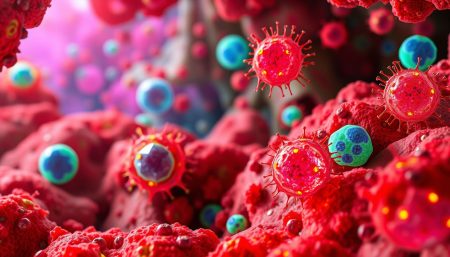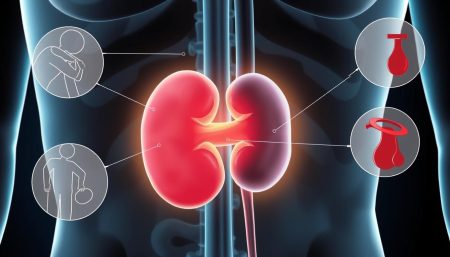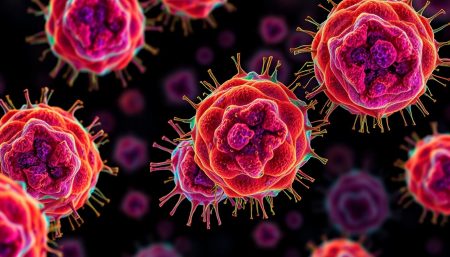Lymphoma cancer is a complex blood disorder that affects the lymphatic system. This system is key to our body’s defense against illness. This guide will help you understand lymphoma, including its two main types: Hodgkin’s lymphoma and non-Hodgkin’s lymphoma.
We’ll look at the symptoms, causes, and treatment options for this challenging condition.
Whether you’re a patient, caregiver, or just someone who cares about health, knowing about lymphoma cancer is important. This guide will help you understand the early signs and treatment choices. Let’s explore the world of lymphoma together and learn the facts you need to know.
What is Lymphoma Cancer: An Overview
Lymphoma cancer impacts the lymphatic system, a key part of our immune defense. This system helps remove toxins and waste from our body.
The Role of the Lymphatic System
The lymphatic system is vital for our immune health. It produces cells that fight off infections. When lymphoma occurs, it harms this system, causing severe health problems.
How Cancer Develops in Lymph Nodes
Lymphoma starts with abnormal lymphocytes, a type of white blood cell. These cells accumulate in lymph nodes, causing swelling. As it spreads, it can harm other lymphatic system parts and organs.
Impact on Immune System Function
Lymphoma cancer weakens our immune system. This makes it harder to fight off infections. It can lead to frequent illnesses and other health issues. Knowing how lymphoma affects the body is essential for finding effective treatments.
| Lymphoma Type | Affected Cells | Common Symptoms |
|---|---|---|
| Hodgkin’s Lymphoma | Reed-Sternberg cells | Swollen lymph nodes, fever, night sweats |
| Non-Hodgkin’s Lymphoma | B-cells or T-cells | Enlarged lymph nodes, fatigue, weight loss |
Types of Hodgkin’s Lymphoma
Hodgkin’s lymphoma is a special type of lymphoma cancer. It has Reed-Sternberg cells, big abnormal lymphocytes in lymph nodes. It’s split into two main types: classical Hodgkin’s lymphoma and nodular lymphocyte-predominant Hodgkin’s lymphoma.
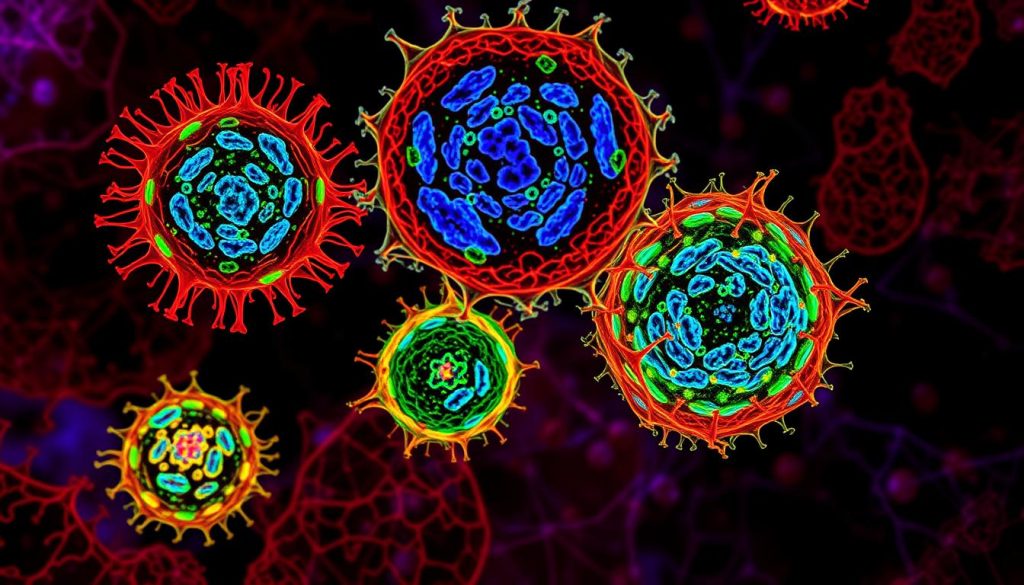
Classical Hodgkin’s lymphoma makes up about 95% of cases. It has four subtypes:
- Nodular sclerosis: Most common, often affecting young adults
- Mixed cellularity: More frequent in older adults
- Lymphocyte-rich: Rare, with a better prognosis
- Lymphocyte-depleted: Least common, typically seen in older individuals or those with HIV
Nodular lymphocyte-predominant Hodgkin’s lymphoma is rarer, making up only 5% of cases. It’s different from classical types, with “popcorn cells” instead of Reed-Sternberg cells. This type grows slower and may need different treatments.
Knowing about these Hodgkin’s lymphoma subtypes is key for correct diagnosis and treatment planning. Each type reacts differently to treatments. This affects the patient’s overall outcome and care plan.
Understanding Non-Hodgkin’s Lymphoma Varieties
Non-Hodgkin’s lymphoma is a group of blood cancers that affect the lymphatic system. It has many subtypes, each with its own characteristics and treatment options.
B-cell Lymphoma Classifications
B-cell lymphomas make up about 85% of non-Hodgkin’s lymphoma cases. These cancers start from abnormal B lymphocytes, which are white blood cells that make antibodies. Some common types are:
- Diffuse large B-cell lymphoma
- Follicular lymphoma
- Mantle cell lymphoma
- Burkitt lymphoma
T-cell Lymphoma Variants
T-cell lymphomas make up about 15% of non-Hodgkin’s lymphoma cases. They start from T lymphocytes, which are important for cell-mediated immunity. Some T-cell lymphoma types include:
- Peripheral T-cell lymphoma
- Cutaneous T-cell lymphoma
- Anaplastic large cell lymphoma
Rare Lymphoma Types
Some lymphomas are less common but important to know. These include:
- Lymphoplasmacytic lymphoma
- Marginal zone lymphoma
- Primary central nervous system lymphoma
| Lymphoma Type | Cell Origin | Frequency |
|---|---|---|
| B-cell lymphoma | B lymphocytes | 85% |
| T-cell lymphoma | T lymphocytes | 15% |
| Rare lymphomas | Varies | <5% |
Early Warning Signs and Symptoms
Spotting lymphoma symptoms early is key for quick diagnosis and treatment. Lymphoma, a cancer of the lymphatic system, shows early signs that might look like other issues.
- Swollen lymph nodes in the neck, armpits, or groin
- Unexplained fever
- Night sweats
- Persistent fatigue
- Unexplained weight loss
- Itchy skin
Some less common signs include:
- Shortness of breath
- Chest pain or pressure
- Cough or chest discomfort
- Abdominal pain or swelling
Symptoms can change based on the lymphoma type and where it is in the body. Some people might have many symptoms, while others might only notice a few.
| Symptom | Hodgkin Lymphoma | Non-Hodgkin Lymphoma |
|---|---|---|
| Swollen lymph nodes | Common | Common |
| Fever | More frequent | Less frequent |
| Night sweats | Common | Less common |
| Fatigue | Common | Common |
| Weight loss | Common | Less common |
If you keep getting the same lymphoma symptoms, see a doctor right away. Catching it early can make a big difference in how well you’ll do.
Risk Factors and Causes of Lymphoma Cancer
It’s important to know about lymphoma risk factors and causes. This knowledge helps in preventing and detecting the disease early. Researchers have found several factors that might raise your risk of getting lymphoma.
Genetic Predisposition
Some people are born with genetic mutations that make them more likely to get lymphoma. If your family has a history of lymphoma or blood cancers, you might be at higher risk. Also, certain inherited immune system disorders can increase your risk.
Environmental Risk Factors
Being exposed to certain chemicals and radiation can lead to lymphoma. Workers in industries with pesticides, solvents, or high radiation are at higher risk. Studies also show that long-term air pollution exposure can raise lymphoma rates.
Medical Conditions That Increase Risk
Some medical conditions can also raise your risk of lymphoma. These include:
- Autoimmune diseases like rheumatoid arthritis or lupus
- HIV/AIDS, which weakens the immune system
- Certain viral infections, such as Epstein-Barr virus
- Previous cancer treatments, like chemotherapy or radiation
While these factors don’t mean you’ll definitely get lymphoma, knowing about them is key. It can help in early detection and better treatment outcomes. Regular health check-ups and talking to your doctor are vital for managing your health.
Diagnostic Methods and Testing
Getting a correct lymphoma diagnosis is key for good treatment. Doctors use different tests to find out the exact type and stage of the disease. This usually starts with a physical exam and looking at the patient’s history.
Blood tests are very important in diagnosing lymphoma. They can show abnormal cell counts or markers that point to cancer. Doctors might do a complete blood count, lactate dehydrogenase test, or tests for specific antibodies.
Imaging studies help doctors see where the cancer is. Common scans include:
- CT (computed tomography)
- PET (positron emission tomography)
- MRI (magnetic resonance imaging)
These scans show the size and location of tumors. This helps in planning the treatment.
The most sure way to test for lymphoma is a biopsy. This means taking a small piece of tissue for a closer look. There are different types of biopsies:
- Excisional: Removing an entire lymph node
- Incisional: Taking part of a suspicious area
- Needle: Using a thin needle to get cells
A pathologist looks at the biopsy sample under a microscope. They confirm lymphoma and find out its specific type. This helps doctors decide on the best treatment and predict how the disease will progress.
Understanding Lymphoma Staging
Lymphoma staging is key to knowing how far cancer has spread. It helps doctors choose the best treatment. Cancer staging for lymphoma looks at several important parts.
Stage Classification System
Lymphoma stages go from I to IV. Stage I means cancer is in one spot, while Stage IV means it’s everywhere. Stages II and III are in between. Each stage affects treatment and outlook.
Imaging Technologies Used
Doctors use different imaging tests to stage lymphoma. These include:
- CT scans
- PET scans
- MRI scans
These tests show where cancer cells are in the body. They also check if lymphoma has spread to other organs.
Bone Marrow Assessment
A bone marrow biopsy is often used in lymphoma staging. It checks if cancer cells are in the bone marrow. This involves taking a small bone marrow sample for analysis.
| Stage | Description | Treatment Approach |
|---|---|---|
| I | Single lymph node region | Localized therapy |
| II | Two or more regions on same side of diaphragm | Combined therapy |
| III | Regions or organs on both sides of diaphragm | Systemic treatment |
| IV | Widespread involvement of organs | Intensive systemic therapy |
Knowing about lymphoma staging helps patients understand their diagnosis and treatment. It’s a vital part of the cancer journey. It guides care decisions and sets recovery expectations.
Traditional Treatment Approaches
Lymphoma treatment has made great strides, bringing hope to those diagnosed. It combines proven methods that have shown success over time.
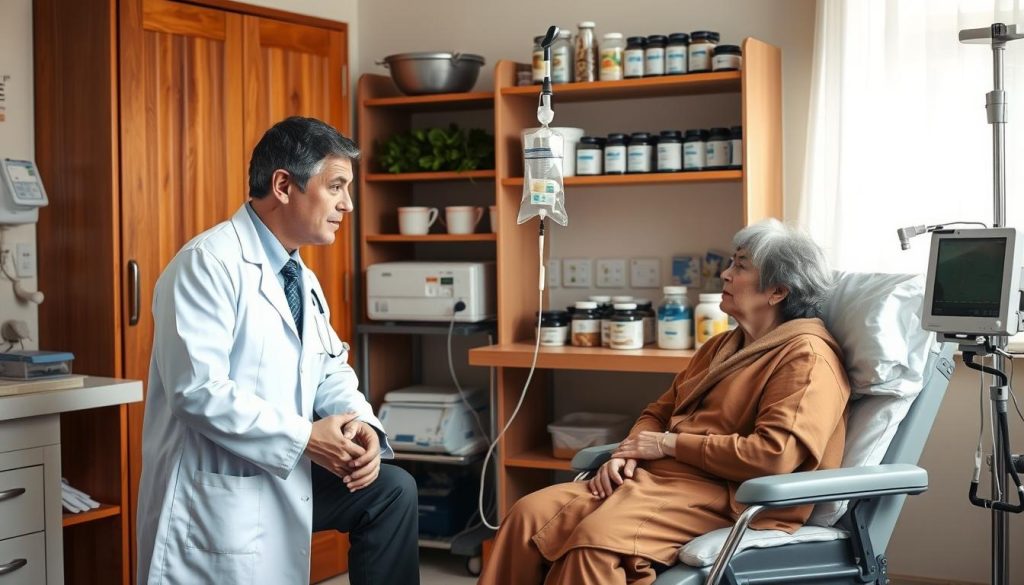
Chemotherapy is a key part of lymphoma treatment. It uses drugs to kill cancer cells everywhere in the body. Chemo is given in cycles, with breaks in between to let the body recover.
Radiation therapy is also vital in fighting lymphoma. It uses beams of energy to shrink tumors. This method is often used for early-stage lymphomas.
For some, stem cell transplantation is a chance for long-term remission. This intense procedure replaces damaged bone marrow with healthy stem cells. It helps the body make healthy blood again. Learn more about bone marrow cancer here.
| Treatment | Main Purpose | Common Side Effects |
|---|---|---|
| Chemotherapy | Destroy cancer cells systemically | Nausea, hair loss, fatigue |
| Radiation Therapy | Shrink localized tumors | Skin irritation, fatigue |
| Stem Cell Transplant | Rebuild healthy bone marrow | Increased infection risk, graft-versus-host disease |
These treatments can be hard on the body but offer a path to recovery for many. Your healthcare team will help find the best treatment plan for you.
Advanced Therapy Options
New treatments for lymphoma are giving patients hope. These modern therapies aim to better outcomes and life quality for those with this disease.
Immunotherapy Developments
Immunotherapy uses the body’s defenses to fight cancer. For lymphoma patients, it’s showing great promise. It enhances the immune system’s power to target and destroy cancer cells. Some patients experience significant improvements with fewer side effects than traditional treatments.
Targeted Drug Treatments
Targeted therapy targets specific cancer cell features. These drugs aim at lymphoma while protecting healthy cells. This precise method often results in better results and fewer side effects. As research advances, more targeted treatments are emerging, giving patients new choices.
Clinical Trial Opportunities
Clinical trials are key in improving lymphoma care. They test new treatments and therapies. Patients in trials may get access to the latest treatments not yet available. These studies also aid in developing better treatments for all lymphoma patients.
| Treatment Type | How It Works | Potential Benefits |
|---|---|---|
| Immunotherapy | Boosts immune system | Fewer side effects, long-lasting responses |
| Targeted Therapy | Attacks specific cancer features | Precision treatment, less damage to healthy cells |
| Clinical Trials | Tests new treatments | Access to latest therapies, advances research |
These advanced treatments mark a new era in lymphoma care. As research keeps advancing, patients have more options to fight their disease effectively.
Managing Side Effects During Treatment
Dealing with cancer treatment side effects can be tough. It’s important to understand and prepare for these challenges. Good symptom management can greatly improve your life during treatment.

Fatigue is a common side effect of lymphoma treatments. To find relief, try:
- Short naps throughout the day
- Light exercise, like gentle walks
- Balanced nutrition
- Proper hydration
Nausea and vomiting can be hard to handle. To manage symptoms, consider:
- Anti-nausea medications
- Eating smaller, frequent meals
- Avoiding strong odors
- Ginger tea or candies
Immune system suppression is a big concern. To stay safe, remember to:
- Practicing good hygiene
- Avoiding crowds and sick individuals
- Getting recommended vaccinations
- Eating a balanced diet rich in fruits and vegetables
Hair loss, though temporary, can be tough emotionally. To cope, you can:
- Cutting hair short before treatment
- Using gentle hair care products
- Exploring wig options or stylish head coverings
- Joining support groups for emotional support
Remember, everyone’s experience with cancer treatment side effects is different. Talking openly with your healthcare team is key. They can help with personalized symptom management and care.
Living with Lymphoma: Lifestyle Adjustments
Living with lymphoma means paying close attention to your lifestyle. Choosing the right foods and staying active can greatly improve your life. This is true both during and after treatment.
Nutrition Guidelines
Eating well is key for lymphoma patients. Eat foods that boost your immune system and help you stay at a healthy weight. Make sure to include lots of fruits, veggies, lean proteins, and whole grains in your diet.
| Food Group | Recommended Choices | Benefits |
|---|---|---|
| Fruits | Berries, citrus fruits, apples | Rich in antioxidants, boost immunity |
| Vegetables | Leafy greens, broccoli, carrots | Provide essential vitamins and minerals |
| Proteins | Fish, chicken, beans | Support muscle maintenance and repair |
| Grains | Quinoa, brown rice, oats | Offer sustained energy and fiber |
Exercise Recommendations
Exercise is good for lymphoma patients. It can help you feel less tired, improve your mood, and keep your muscles strong. Start with easy activities like walking or swimming. Then, slowly add more intense exercises as you get stronger.
Stress Management Techniques
It’s important to manage stress well. Try deep breathing, meditation, or yoga to relax. Doing things you enjoy and spending time with loved ones can also help. These activities can reduce anxiety and improve your mental health while dealing with lymphoma.
Support Resources and Care Networks
Facing lymphoma can feel overwhelming, but you’re not alone. Lymphoma support groups and cancer care networks offer great help. They provide emotional support, practical advice, and a sense of community.

Many hospitals and cancer centers have in-person lymphoma support groups. These meetings let patients share experiences and find comfort in others who get it. Online forums and virtual groups offer similar support, but are easier to access.
Cancer care networks do more than just offer emotional support. They also provide:
- Educational resources about lymphoma
- Financial assistance programs
- Transportation services to medical appointments
- Counseling services for patients and families
Groups like the Lymphoma Research Foundation and the Leukemia & Lymphoma Society offer a lot of help. Their websites have webinars, educational materials, and helplines with oncology experts.
| Support Resource | Services Offered |
|---|---|
| Local Hospital Support Groups | In-person meetings, peer support |
| Online Communities | 24/7 access, diverse global perspectives |
| National Organizations | Educational resources, financial aid, counseling |
| Cancer Care Networks | Practical assistance, medical referrals |
Remember, asking for help is a sign of strength. Joining lymphoma support groups and cancer care networks can greatly improve your life during treatment and after.
Survival Rates and Prognosis Factors
Learning about lymphoma prognosis and cancer survival rates can help a lot. It gives insights to patients and their families. The outlook for lymphoma changes a lot based on several factors.
Hodgkin lymphoma has a 5-year survival rate of about 87%. Non-Hodgkin lymphoma’s rate is slightly lower, at around 73%. These numbers are averages for all stages and types. But, individual results can vary a lot.
Important factors that affect lymphoma prognosis include:
- Age at diagnosis
- Overall health status
- Specific lymphoma subtype
- Stage of the disease
- Response to treatment
Early-stage lymphomas usually have better outcomes than advanced ones. For example, stage 1 non-Hodgkin lymphoma’s 5-year survival rate is about 83%. But, for stage 4, it’s around 65%.
It’s important to remember that cancer survival rates are based on past data. They might not show the latest treatment progress. Many patients live longer than these estimates, and some even get cured. Regular check-ups and sticking to treatment plans are key to better results.
Prevention and Risk Reduction Strategies
While we can’t completely prevent lymphoma, there are ways to lower your risk. A healthy lifestyle is the first step. Eat lots of fruits and veggies. They’re full of vitamins and antioxidants that help your immune system.
Regular exercise is also important. Try to do at least 30 minutes of moderate activity every day. This could be walking, swimming, or cycling. Exercise helps keep you healthy and boosts your immune system.
It’s also key to avoid harmful substances. Quitting smoking is a big step towards prevention. Drink alcohol in moderation and avoid chemicals from work or home. These actions can greatly reduce your cancer risk.
Don’t forget to get regular health check-ups. Early detection is key to successful treatment. If you notice anything strange, see your doctor right away. By being proactive, you’re taking care of your health for the long run.
FAQ
Q: What is lymphoma cancer?
A: Lymphoma cancer is a blood cancer that affects the lymphatic system. This system is key to our immune defense. It happens when lymphocytes, a type of white blood cell, grow too much. There are two main types: Hodgkin’s lymphoma and non-Hodgkin’s lymphoma, each needing different treatments.
Q: What are the common symptoms of lymphoma?
A: Symptoms include swollen lymph nodes, feeling very tired, and losing weight without trying. You might also have night sweats, fever, itchy skin, shortness of breath, or stomach pain. These symptoms can change based on the lymphoma type and stage.
Q: How is lymphoma diagnosed?
A: Doctors use several methods to diagnose lymphoma. They do physical exams, blood tests, and imaging studies like CT scans. A lymph node biopsy is key to confirm the diagnosis and find out the type of lymphoma. This helps decide the best treatment.
Q: What are the main treatment options for lymphoma?
A: Treatments depend on the lymphoma type, stage, and other factors. Options include chemotherapy, radiation, immunotherapy, and targeted drugs. Some might need stem cell transplantation. Clinical trials offer new treatments.
Q: What is the difference between Hodgkin’s and non-Hodgkin’s lymphoma?
A: Hodgkin’s lymphoma has Reed-Sternberg cells, while non-Hodgkin’s lymphoma does not. Non-Hodgkin’s lymphoma is more common and has many subtypes. Treatment and outlook can differ between the two.
Q: Can lymphoma be cured?
A: Many lymphomas can be treated and even cured, mainly if caught early. Cure rates depend on the type, stage, and overall health. Hodgkin’s lymphoma often has a higher cure rate than non-Hodgkin’s. Even without a cure, long-term remission and management are possible.
Q: What are the risk factors for developing lymphoma?
A: Risk factors include age, a weakened immune system, exposure to chemicals, and viral infections. Family history and genetic conditions can also play a role.
Q: How does lymphoma staging work?
A: Staging shows how far the disease has spread and guides treatment. It ranges from Stage I (local) to Stage IV (widespread). Staging involves exams, imaging tests, and sometimes bone marrow biopsies. The stage is key for choosing the right treatment.
Q: What side effects can I expect from lymphoma treatment?
A: Side effects include fatigue, nausea, hair loss, and increased infection risk. Chemotherapy and radiation can have short- and long-term effects. Your healthcare team will help manage these and keep your quality of life high.
Q: Are there any lifestyle changes that can help during lymphoma treatment?
A: Yes, making lifestyle changes can help. Eat a balanced diet, exercise gently, practice stress-reduction, and get enough rest. Avoid tobacco and limit alcohol. Always talk to your healthcare team before making big changes.













